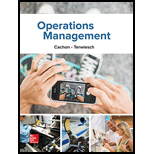
Operations Management
17th Edition
ISBN: 9781259142208
Author: CACHON, Gérard, Terwiesch, Christian
Publisher: Mcgraw-hill Education,
expand_more
expand_more
format_list_bulleted
Concept explainers
Question
Chapter 17, Problem 6CQ
Summary Introduction
To determine: The true statement from the following.
Expert Solution & Answer
Want to see the full answer?
Check out a sample textbook solution
Students have asked these similar questions
In an M/MA queueing system, the arrival rate is 9 customers per hour and the service rate is 12 customers per hour. (Round your
answers to 3 decimal places.)
a. What is the probability that the server will be idle?
Probability
b. What is the probability of having exactly 4 customers in the system?
Probability
c. What is the probability of having 3 or fewer customers in the system?
Prubabty
d. What is the expected number of customers in the queue(La)? (Round your answer to 3 decimal pleces.)
Expected number of customers
e. What is the expected waiting time in the queue(Ng)? (Express the waiting time in hours, round your answer to 3 decimal pleces)
Expected wasting time
Choose the best Option, Short explanation of one-two sentences needed.
On average, a service facility experiences 10 customers arriving per hour and a single server can serve 15 customers per hour. Arrival rates and service rates both follow a Poisson distribution.
Waiting lines form at this facility because there is not enough average service capacity.
No waiting lines form at this facility because the average arrival rate is less than the average service rate.
No waiting lines form at this facility because the utilization is less than 1.
Waiting lines form at this facility because of variability in interarrival times and service times.
What can you say about the relationship between W and Wq in a stable queuing system with ?
W is always greater than Wq
W is always less than Wq
W is always equal to Wq
It depends on the type of queuing system
If emails arrive to my mailbox according to a Poisson process at a rate of 10 per hour and the time it takes me to “deal with” an email…
Using an M/M/1 queuing system as an example demonstrate how the event list in a simulation model would evolve over 5 discrete steps if the first part will arrive at time zero, the time between the next four arrivals are 3, 5, 6, and 4 minutes and that the machining times for the first five parts are 6, 4, 3, 5, and 4 minutes. The performance metrics of interest are the average queue length and the number of items processed.
Knowledge Booster
Learn more about
Need a deep-dive on the concept behind this application? Look no further. Learn more about this topic, operations-management and related others by exploring similar questions and additional content below.Recommended textbooks for you
 Practical Management ScienceOperations ManagementISBN:9781337406659Author:WINSTON, Wayne L.Publisher:Cengage,
Practical Management ScienceOperations ManagementISBN:9781337406659Author:WINSTON, Wayne L.Publisher:Cengage,

Practical Management Science
Operations Management
ISBN:9781337406659
Author:WINSTON, Wayne L.
Publisher:Cengage,